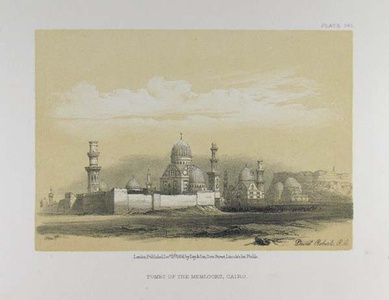| Method | Lithograph with tint stone |
| Artist | after David Roberts |
| Published | London, Published Decr. 15th. 1856 by Day & Son, Gate Street, Lincoln's Inn Fields |
| Dimensions | Image 120 x 172 mm, Sheet 195 x 285 mm |
| Notes |
Plate 245 from Volume 6 of the small format reprint of Roberts' The Holy Land, Syria, Idumea, Arabia, Egypt & Nubia. A view of 'el-Arafa,' the Islamic necropolis or 'City of the Dead' of Cairo, Egypt. The necropolis was founded in the 7th century AD after the Muslim conquest of Egypt. The original cemetery was built for the family of the Arab commander Amr ibn al-Al' at the foot of the Mokattam hill. The cemetery became a site of pilgrimage in the Fatimid era, and eventually became the preferred place of burial for the Fatimid caliphs, and later the Sultans and nobles of the Mamluk and Ottoman era. Roberts's view shows a collection of the partly ruinous tomb-complexes of the caliphs. The Citadel of Cairo is visible on the horizon. David Roberts RA (24th October 1796 – 25th November 1864) was a Scottish painter. He is especially known for a prolific series of detailed prints of Egypt and the Near East produced during the 1840s from sketches made during long tours of the region (1838-1840). This work, and his large oil paintings of similar subjects, made him a prominent Orientalist painter. He was elected as a Royal Academician in 1841. The firm of Day & Haghe was one of the most prominent lithographic companies of the nineteenth-century. They were also amongst the foremost pioneers in the evolution of chromolithography. The firm was established in 1823 by William Day, but did not trade under the moniker of Day & Haghe until the arrival of Louis Haghe in 1831. In 1838, Day & Haghe were appointed as Lithographers to the Queen. However, and perhaps owing to the fact that there was never a formal partnership between the two, Haghe left the firm in the 1850's to devote himself to watercolour painting. The firm continued as Day & Son under the guidance of William Day the younger (1823 - 1906) but, as a result of a scandal involving Lajos Kossuth, was forced into liquidation in 1867. Vincent Brookes bought the company in the same year, and would produce the caricatures for Gibson Bowles' Vanity Fair magazine, as well as the illustrations for Cassells's Poultry Book, amongst other commissions. Condition: Slight foxing to margins, not affecting image. Large ink stain on right edge of sheet, not affecting image. |
| Framing | unmounted |
| Price | £25.00 |
| Stock ID | 39071 |

